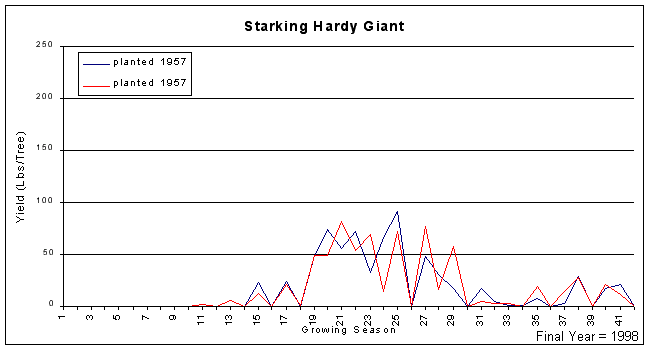Starking Hardy Giant
Average nut quality of test trees.
| # Nuts / lb. | % Kernel | Kernel quality breakdown | Specific gravity | ||
| % Fancy | % Standard | % Amber | |||
| 84 | 50% | 11% | 26% | 13% | .80 |
History
'Starking Hardy Giant' resulted from a campaign started in 1938 by George James to find the best pecan for the central Missouri district. James found what he believed to be the tree in 1947. Stark Brothers contracted for propagation, and in 1955 a patent was issued to the Stark Brothers Nursery for the tree (Sparks, 1992). It is a parent of 'Pawnee'.
Comments
*Note: This is an older cultivar planted in the Young Variety Test at the Tifton Campus. Trees were planted decades ago when care was very different than it is now, and trees received much less care, so production data will reflect this fact. Trees began receiving insecticides in 1962, fungicides in 1970, nitrogen in 1962, and drip irrigation in 1975. The data for this cultivar was collected by several individuals, but the bulk of the data and the comments are from my predecessor Dr. Ray Worley. This information was originally published here: Worley and Mullinix, 1997.
It is no giant, its size is modest at best. It is the earliest maturing nut in the test, with shuck split in August, and earliness is its major redeeming quality. However, earliness and small nut size make it extremely susceptible to predatory losses. It may have a place in northern areas or for a super early market if one developed. It is not adapted to South Georgia, and many years the nuts fail to develop properly and fall off the tree.
Production record of test trees beginning in year planted
'Starking Hardy Giant' production from the Young Variety Test. Each colored line represents the yearly production in pounds of nuts from an individual tree beginning the year planted.



